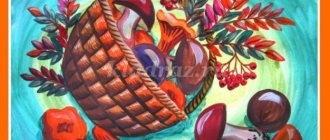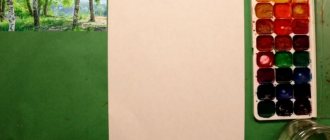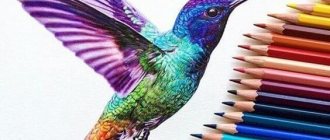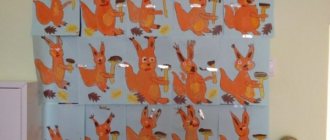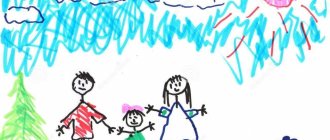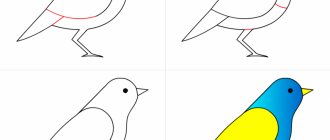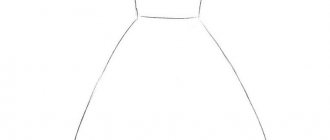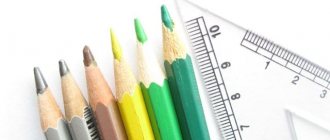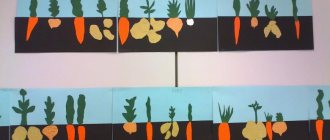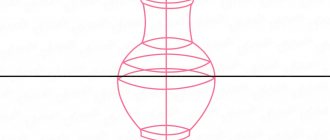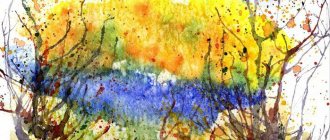Summary of a drawing lesson in the senior group on the topic “Still life with vegetables”
Polyak Yana Nikolaevna
Summary of a drawing lesson in the senior group on the topic “Still life with vegetables”
Goal: to create conditions for strengthening children’s ability to convey the shape, color, and characteristic features of vegetables .
- continue to introduce children to the fine arts - introduce them to still life and its features;
- consolidate the ability to determine the shape and color of objects;
- activate children's vocabulary;
- consolidate the ability to use wax crayons.
- develop interest, the ability to admire the content and beauty of paintings;
- cultivate aesthetic feelings, the desire to complete the work started.
Examination of paintings by various artists, clarifying knowledge about drawing .
Materials and equipment: Reproduction of a painting depicting
still life , dummies of 3-4 vegetables , fabric, album sheets, simple pencils, wax crayons.
How to draw a still life with fruit in gouache step by step for beginners
Master class on drawing for preschoolers “Still lifes with vegetables and fruits” Olga Stanislavovna Sredina, teacher, Central Children’s Educational Institution No. 1 “Bear Cub”, Yuryuzan, Chelyabinsk region.
Goal: - creation of educational work Objectives: - teach techniques for working with gouache without preliminary drawing - improve compositional skills - develop the ability to work with a brush (draw parallel lines, draw a “mesh” pattern) - cultivate a sense of harmony - introduce genres of painting - consolidate knowledge of vegetables and fruits - introduce the concept of glare Materials: Album (two sheets), gouache, soft brushes No. 8, 5, 3, 1 Preliminary work: - familiarization with still lifes (from the Internet) Paintings with vegetables Paintings with fruits Games (before or after class) : 1. Find a still life (among postcards with portraits and landscapes) 2. Find funny and sad still lifes (among magazine illustrations in A3 format) 3. Make a still life (the first option is puzzles, the second is overhead parts) A3 format. 4. Divide the cards into two piles (vegetables and fruits) Quote: Highlight is an element of chiaroscuro. This is a spot of light on a brightly lit surface. Occurs due to the reflection of a light source (sun, light bulb) on an object. Blick - (German: Blick look, fleeting shine). 1) an ingot of silver, cleared of lead. 2) the most illuminated point in the picture. Work progress: VEGETABLES Open the album (two pages). On the right page we draw the table plane in dark green or emerald color.
Draw the silhouette of a plate (bowl) in blue and paint over it. The silhouette looks like a boat.
We draw red tomatoes in a bunch of several pieces.
We place oval light green cucumbers along the edges. Place the potato (or turnip) on the table. Draw a curtain using ocher or yellow.
Use dark green to paint spots and twigs on cucumbers, twigs and leaves on tomatoes.
We draw patterns on the curtains and a shadow on the potato.
We paint highlights with whitewash on vegetables.
We outline the bowl with purple. We draw a pattern of parallel lines, first in one direction and then in the other direction.
FRUIT Draw the table surface blue. Brown color – silhouette of a bowl.
We repeat the pattern. First, parallel stripes in one direction, and then in the other direction.
The yellow curtain is drawn on one side. A pear (ochre), a yellow apple and an orange appear in the vase. If desired, the amount of fruit can be increased.
Some fruit appears on the table. Cherries can be scattered on the table and added to the bowl.
Using a thin brush, draw branches from cherries, pears, and apples. Pears and apples also have green leaves.
Red stripes are added to the sides of the apple, spots are added to the skin of the oranges, and highlights are added to all fruits.
Children's works:
We recommend watching:
Drawing a still life in elementary school step by step Decorative still life in gouache step by step with photos for children from 7 years old Drawing a still life for older children step by step with photos Decorative still life. Drawing step by step with photos
Similar articles:
Applique print. Still life "Fruit"
How to draw a still life
MAGAZINE Preschooler.RF
(speech development, music, application) 1. Objectives: 1.1. arouse in children an active interest and emotional response to works of art; 1.2. the desire to carefully examine a still life, admire the beauty of objects, the unusualness of their shape, color, combination of objects, compositions; 1.3. give an idea of what objects are depicted in a still life; 1.4. stimulate aesthetic evaluations and judgments. 2. Vocabulary work: still life, dummies, vegetables, fruits, berries, flowers, paintings, artists, etc. 3. Methodological support: 3.1. paintings: I. Levitan “Cornflowers”; I. Khrutsky “Still life with mushrooms”; I. Petrov-Vodkin “Apple and Cherry.” 3.2. recording of the melody “Sentimental Waltz”. 3.3. dummies of vegetables, fruits, mushrooms, berries, etc. 3.4. ceramic vases (of different shapes and heights). 3.5. "Gzhel" vases. 3.6. colored paper, brushes, glue.4. Preliminary work: Didactic games, reading works about vegetables, fruits, mushrooms. Making and guessing riddles. Drawing with pencils and paints on the theme “Gifts of Autumn”. Symmetrical cutting of various vases. 5. Progress of the lesson: Still lifes by artists I. Levitan, I. Khrutsky, I. Petrov-Vodkin are hung in the group; still lifes made from colored paper by the hands of children and teachers. (Children look at the paintings while listening to quiet music). Children, did you like the exhibition? Which paintings did you like the most? Why? What do you think the artist wanted to tell us in this picture? What mood do you get when you look at this picture? What colors did the artist use? Bright, warm or cool? You and I have seen different pictures. They depict flowers, vegetables, mushrooms, books, paints, dishes, etc. In life, sometimes you notice the beauty of objects, and artists are very attentive people. They are pleased and surprised by the elegance of objects, their shapes, unusualness, and colors. When an object is depicted on canvas, it is especially beautiful. When an artist composes a still life, he tries to place the main objects so that the rest decorate and complement them. But the artist talks not only about objects, but also about the people who created, decorated, and grew them. People eat picked flowers, fruits, and berries, but those drawn by the artist will live forever and delight us. Paintings that depict flowers, berries, fruits, vegetables, and household items are called still life. Still life If you see in the picture a Cup of coffee on the table, Or a pond in a large decanter, Or a rose in crystal, Or a bronze vase, Or a pear, or a cake, Or all the objects at once - Know that this is a still life. In our group we have many beautiful household items (vases, cups, glasses, candy dishes, etc.). There are also a lot of beautiful berries, fruits, vegetables (dummies). Guess the riddles that I will tell you. These items can be used to create a still life composition. The red maiden sits in prison, and is planted on the street (carrot). I am long and green, tasty and salty, tasty and raw, who am I? (cucumber). The grandfather is sitting, dressed in a fur coat, whoever undresses him sheds tears (bow). The size of a fist, red side. If you touch it with your finger, it’s smooth, but if you bite it, it’s sweet (apple). There are balls hanging on the branches that have turned blue from the heat (plums). The teacher invites the children to create a still life from those items that are in the group (vases, household items, fruits, vegetables, dummies of berries) and talk about it. Child: I took a vase, put beautiful asters in it, put a cucumber and a tomato on the right, and a plum and lemon on the left. I really liked the still life. Child: I made a still life. I took a beautiful vase of fruit and put a sprig of rowan on the right. On the left is a jug of fruit juice. Educator: Guys, let's all try to create our own still life together. Let's do a lot of collective work. Each of you will select the elements of the still life separately, and then we will combine them together. But first, let's imagine on a flannelgraph. If any of you would like to carve something of your own for our still life, please do so. Everything you need is available. After this, the children begin to work with paper. Everyone does collective work together, coordinating their actions with the actions of other children. After work, they come up with a name for the still life. Children work to music. 6. Summary of the lesson: Classes within the framework of this genre allow children to get acquainted with the direction of fine painting still life, introduce children to the famous works of still life masters. I invite children to admire the beauty of objects, their combination, and feel the range while listening to music.
Larina Valentina Vasilyevna Teacher of the highest category, MDOU kindergarten No. 4 “Ivushka” of a combined type, Reutov
| Next > |
